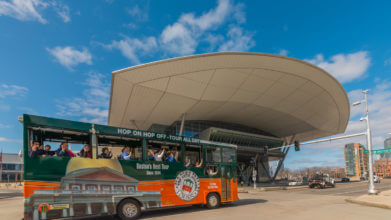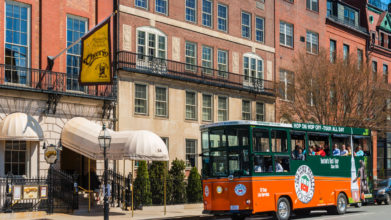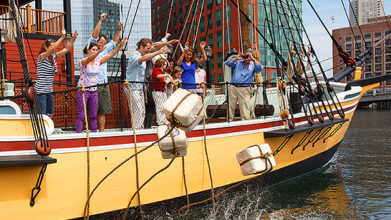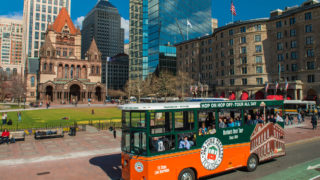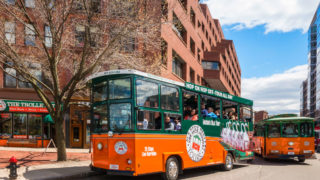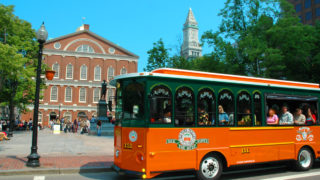Must See Boston Landmarks Guide for Your Vacation
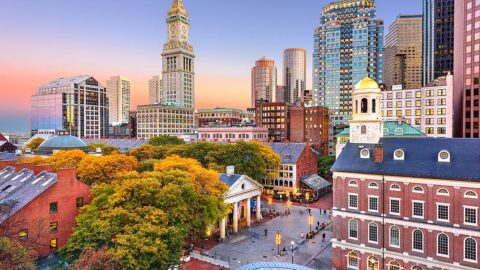
Boston, a city steeped in historical charm and modern innovation, is a must-visit destination for discerning travelers. This vibrant metropolis is a treasure trove of iconic landmarks, from the cobblestone streets of the Freedom Trail to the hallowed halls of Harvard University. Whether you’re a history buff, a foodie, or simply a curious explorer, Boston’s eclectic mix of attractions provides countless opportunities for discovery.
Explore Boston like never before on the Old Town Trolley. It’s not just a ride, but a captivating journey into the heart of this vibrant city. Our trolleys effortlessly navigate Boston’s iconic streets, offering a unique perspective of its historic landmarks. From the grandeur of the State House to the bustling energy of Quincy Market, we’ve got you covered. With our convenient hop-on, hop-off feature, you can explore at your own pace, immersing yourself in the sights that intrigue you the most.
Old North Church History
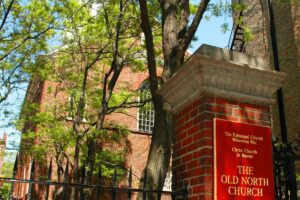
Today, the Old North Church is a National Historic Landmark and a key feature on Boston’s Freedom Trail. It continues to attract visitors from around the globe, drawn by its remarkable history and well-preserved Colonial architecture. A visit to the Old North Church offers a unique opportunity to step back in time and relive a critical chapter of America’s past while enjoying a magnificent example of early American craftsmanship.
What To See at the Old North Church
The Old North Church, built in the Georgian architectural style, is a testament to the meticulous craftsmanship of early American artisans. Its two-tiered box-pewed gallery and beautifully detailed pulpit exhibit an elegance and symmetry typical of Georgian design.
The bell tower at the Old North Church, originally constructed in 1723, is a marvel of early 18th-century engineering. Inside this architectural feat, you’ll find the church’s historic bells, originally cast in Gloucester, England. These eight change-ringing bells are the oldest in the United States still in operation, their melodious chimes echoing the annals of American history.
Descending into the crypt, a fascinating tour awaits. The crypt houses 37 tombs, laid between 1732 and 1860. As you journey through this captivating burial site, you’ll encounter the final resting places of many notable Bostonians, their stories narrated by knowledgeable guides.
While visiting, don’t miss the Clough House, one of Boston’s oldest surviving brick residences located just adjacent to the church. Here, you’ll find the Printing Office of Edes & Gill, a Colonial-era printing office, and Captain Jackson’s Historic Chocolate Shop.
Paul Revere House History
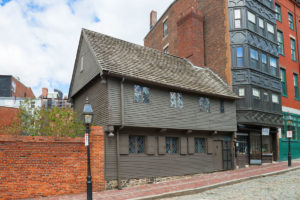
Paul Revere himself is an iconic figure in American history, recognized for his pivotal role in the nascent stages of the Revolutionary War. Born in Boston in 1735, Revere was a silversmith by trade and a patriot at heart. He was a central figure in the city’s resistance against British authority, most notably conducting the legendary “Midnight Ride” in 1775 to alert Colonial militias of incoming British forces. Revere’s home, now a revered historic site, was built around 1680 and became Revere’s residence in 1770.
What To See at the Paul Revere House
The Paul Revere House, a gem nestled in the heart of Boston, offers a fascinating glimpse into the life and times of one of America’s most celebrated patriots. As you step inside, you’re immediately transported back to the Colonial era. The house, which retains its original wooden beams and fireplaces, is a time capsule of 17th-century architecture.
Revere’s possessions, carefully preserved, tell a story of both his personal life and his trade. A silversmith by profession, Revere was known for his skilled craftsmanship. One of the most captivating exhibits is his workbench, still showcasing various tools of the trade — hammers, molds, and polishing stones.
While touring the house, make sure to explore the courtyard, which boasts an elegant colonial garden, and visit the on-site gift shop that offers a wide selection of books, prints, and handcrafted items. Also, take time to appreciate the Paul Revere Memorial, a stone monument that pays homage to the legendary patriot.
Boston Tea Party Ships & Museum History
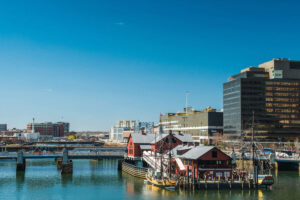
The museum masterfully captures the spirit of rebellion and political protest that marked the era. The Boston Tea Party was an audacious response to the Tea Act passed by the British Parliament in 1773. American colonists, chafing under the legislation, which imposed a tax on tea and maintained a monopoly for the British East India Company, staged an innovative protest.
What To See at the Boston Tea Party Ships & Museum
At the Boston Tea Party Ships & Museum, you’ll be immersed in a riveting period of history. Begin your visit at the Meeting House, where you can participate in a town meeting to discuss the Tea Act’s controversies. Surrounded by Colonial-era decor and passionate reenactors, you’ll feel like you’ve been transported back to 1773.
Next, step outside to Griffin’s Wharf, a meticulously replicated scene of the original port where the infamous Tea Party took place. Here, you’ll see two restored tea ships, the Eleanor and the Beaver. Climb aboard these vessels and join the Sons of Liberty in tossing mock tea crates into the harbor, an interactive experience that brings the spirit of defiance to life.
Afterward, take a breather at Abigail’s Tea Room & Terrace, where you can sample five types of Colonial tea and enjoy some traditional New England fare. The room offers a panoramic view of the harbor, adding to the historic atmosphere.
The highlight of the tour is the original Robinson tea chest from 1773, one of only two tea chests known to have survived the Boston Tea Party. Encased in glass, the chest can be viewed but not touched, preserving its fragile condition.
Old State House History
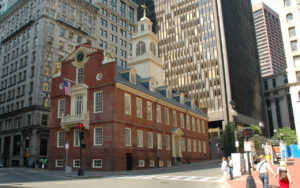
In the wake of the Revolution, the Old State House transitioned from a symbol of British authority to an emblem of American independence. It was here that several significant events leading up to the Revolution, including the Boston Massacre of 1770, unfolded. Today, the building houses the Bostonian Society’s museum, which features exhibits detailing the city’s Colonial history.
What To See at the Old State House
Inside the Old State House, visitors will be awed by the mastery of British Colonial architecture. The council chamber on the second floor, once the meeting place of the highest officials in the colony, is adorned with ornate woodwork, richly colored wall hangings, and a grand chandelier that harks back to the grandeur of the 18th century. The royal lion and unicorn statues, symbols of the British monarchy, stand imposingly on the east side of the building, reinstated in 1882 after being burned in a bonfire when the Declaration of Independence was read. Under the balcony of the Old State House, visitors will find the Boston Massacre Memorial.
The Old State House’s exhibits bring history to life with a collection of artifacts, interactive displays, and informative plaques. The “Voices of Protest” exhibit is particularly captivating, offering a range of historical perspectives on the origins of American democracy and the part Boston played in it.
Symphony Hall History
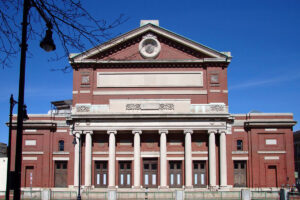
Symphony Hall is famous not just for its design and acoustics, but for the caliber of performances it has hosted over the years. It has been the stage of countless concerts by the Boston Symphony Orchestra, one of the “Big Five” American orchestras and a globally acclaimed ensemble.
What To See at Symphony Hall
A visit to Symphony Hall in Boston is an unforgettable experience, steeped in grandeur and history. The hall’s beautiful interior is adorned with 16 casts of notable Greek and Roman statues lining the upper level of the walls. These replicas of ancient classics are divided into 10 mythical subjects and six historical figures, adding an air of classical sophistication to the Hall’s aesthetic.
The beauty of Symphony Hall doesn’t end with the music. Its architecture is an artwork in itself, designed with meticulous attention to detail. The high vaulted ceilings and the striking proscenium arch are examples of the architectural prowess that went into creating this cultural icon. But, perhaps the jewel in the crown is the Symphony Hall organ. Installed in 1900, it boasts over 4,800 pipes, and its resonant sound is a key element of the hall’s exceptional acoustics.
The hall is renowned for its regular schedule of concerts and performances from an array of world-class artists. The Boston Symphony Orchestra, a regular at the Symphony Hall, frequently graces the stage, showcasing its immense talent and versatility across a range of musical genres. Visitors can revel in a diverse program of music, from classical symphonies to contemporary compositions, performed by this globally acclaimed ensemble.
Faneuil Hall History
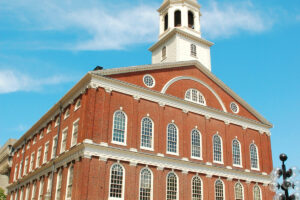
Peter Faneuil, a prosperous businessman and philanthropist, became renowned for his generous gift to the city. Born into a wealthy Huguenot family in New Rochelle, New York, Faneuil moved to Boston. He commissioned the building of Faneuil Hall as a center of commerce for the city, where merchants could gather and conduct their trade. Although he died a year after its completion, his legacy endured through the significant role his gift played in American history.
What To See at Faneuil Hall
Faneuil Hall in Boston brims with intricate details that bring Boston’s history to life. As you approach the hall, a notable sight is the statue of Samuel Adams, a brewer, prominent statesman, and key figure in the American Revolution.
When you step onto the cobblestone promenade of Faneuil Hall, you’re entering a lively hub famed for street performances. This bustling open-air area is often graced by charismatic artists, musicians, jugglers, and magicians, providing a vibrant and entertaining backdrop as you explore the historical surroundings.
Just adjacent to Faneuil Hall is Quincy Market, a historic complex famous for its food colonnade, which hosts over 35 eateries including several stands at which you can get a bowl of the famous New England clam chowder. The bustling market, in operation since 1826, also houses several shops and stalls that offer an array of goods, from souvenirs to artisan crafts.
While visiting Faneuil Hall, don’t miss out on the Great Hall on the second floor. This grand meeting room, with its lofty ceiling, gallery of portraits, and golden eagle atop the U.S. flag, is a tangible connection to the fervor of historic town meetings. The hall’s third floor houses the Ancient and Honorable Artillery Museum, displaying military memorabilia from the 17th century onward.
Beacon Hill History
Beacon Hill carries a distinct significance in Boston’s Colonial history. The area was originally known as Trimountain due to its three peaks, but it was later renamed Beacon Hill because of the beacon that was placed atop the hill to warn locals of foreign invasions. Beacon Hill stands as the epicenter of the antebellum abolitionist movement. It boasts significant landmarks such as the African Meeting House, America’s oldest standing black church. This church became a platform for voicing civil rights issues and played a vital role in the fight against slavery.
Beacon Hill is open to the public year-round, fostering an appreciation for Boston’s history. The neighborhood’s narrow picturesque streets are lined with impeccably preserved 19th-century row houses, lending a unique charm that attracts visitors from around the world. Beacon Hill’s red brick sidewalks, decorative ironwork, and gaslit streetlamps create a step back in time, offering insights into Boston’s Colonial past.
What To See at Beacon Hill
Visitors to Beacon Hill should not miss the opportunity to stroll along Acorn Street, often mentioned as the most photographed street in America. This quaint narrow alleyway with cobblestone pavement and lined by charming historic row houses provides a visually captivating snapshot of old Boston.
The Charles Street Meeting House is another heritage jewel. Once a church, later a synagogue, and now a mixed-use building, it reflects Boston’s diverse social fabric. Known for its Greek Revival architecture and history of social activism, it serves as a symbol of community spirit and the city’s evolving cultural landscape.
The Museum of African American History on Joy Street is another must-visit landmark. Housed in the Abiel Smith School, the country’s oldest building constructed for the education of African-American children, the museum showcases the rich history, culture, and contributions of African Americans in New England. Its collections and exhibits provide profound insights into the African-American struggle for equality, making it an essential part of any Beacon Hill tour.
Boston Common History
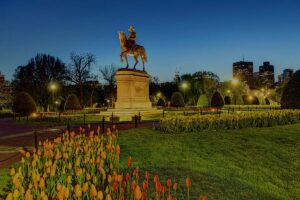
In the fervor of the 18th century, the Boston Common became a hotbed for Revolutionary activity. It hosted numerous public events that stoked the fires of the American Revolution, becoming a symbol of the city’s defiance and resilience. During the British occupation of Boston, Redcoats made the Common their encampment, transforming this public space into a stronghold for eight years.
What To See in the Boston Common
The Soldiers and Sailors Monument, standing tall on the Boston Common’s Flagstaff Hill, is a grand tribute to the state’s Civil War heroes. Unveiled in 1877, this striking monument features a granite obelisk adorned with bronze statues and relief plaques, each narrating compelling stories of valor about the Union forces of Massachusetts. Visitors can delve into the history of the Civil War and pay respect to the sacrifice of the countless soldiers and sailors depicted in the monument’s detailed artwork.
Nearby, the Boston Common Carousel is a favorite among families and children. This vintage-style merry-go-round is a burst of color and joy amid the park’s tranquil greenery. With a variety of beautifully carved and painted animals to ride, the carousel provides an old-world charm that delights the young and the young at heart.
At the heart of Boston Common lies the Boston Frog Pond. It’s a beloved recreational spot that adapts beautifully to New England’s changing seasons. In summer, the pond serves as a spray pool, providing a refreshing escape from the city heat for children and families. Come winter, it transforms into a skating rink, offering an enchanting outdoor activity amid snowy scenery.
Boston Public Garden History
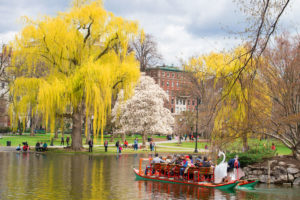
The Public Garden truly came into its own with the addition of the park’s iconic Swan Boats in 1877. These foot-pedaled vessels, with their graceful swan figures, quickly became a symbol of the garden, offering serene rides across the lagoon and contributing significantly to the park’s charm. Today the garden is more than just a park; it is a symbol of Boston’s history, a testament to the city’s commitment to preserving green spaces, and a beloved landmark for locals and tourists alike.
What To See at the Boston Public Garden
The Boston Public Garden is a tapestry of intriguing features, each adding a unique stroke to its overall beauty and charm. At its heart lies the lagoon, a tranquil water body where the famous Swan Boats glide gracefully. A ride on these foot-pedaled vessels is an experience not to be missed. It offers an unrivaled perspective of the garden’s verdant scenery and the city’s architectural skyline.
The 9/11 Memorial, a tribute to the Massachusetts residents who lost their lives in the terrorist attacks, offers a poignant reminder of a dark day in our nation’s history. The “Make Way for Ducklings” statue, celebrating Robert McCloskey’s popular children’s book, has become an endearing symbol of the park, and a favorite photo spot for families.
If you’re visiting in spring, join the annual Duckling Day Parade. This delightful event, inspired by the “Make Way for Ducklings” book, invites children and families to retrace the journey of the Mallard family, starting in the park and ending at the famous duckling statues.
Boston Public Library History
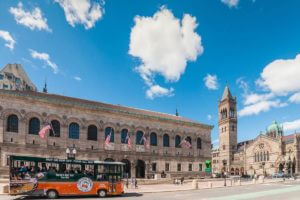
Furthermore, the Boston Public Library is a landmark that should be on any visitor’s itinerary. Its significance in the city’s history and its ongoing contributions to the community make it a must-visit destination for those seeking to fully experience the spirit of Boston.
What To See at the Boston Public Library
The Boston Public Library is a treasure trove of intricate details and architectural wonders. The Abbey Room, also known as the “Delivery Room,” is one of the highlights of the library. It boasts a series of vibrant murals by Edwin Austin Abbey portraying the quest for the Holy Grail in intricate detail. The room’s stunning woodwork, ornamental ceiling, and large fireplace add to its grandeur and historic ambiance.
Venturing outdoors, the courtyard garden is a tranquil oasis in the heart of the city. The garden features a central fountain and is surrounded by an arcade that follows the Italian Renaissance style. It serves as a peaceful retreat, offering visitors a chance to relax amid lush greenery away from the hustle and bustle of city life. It’s also a favorite photo spot by many with the iconic lion statues providing a perfect backdrop for any vacation selfie.
Throughout the year, the library hosts multiple exhibitions in its gallery space. These exhibitions offer a glimpse into the library’s rich collection, showcasing rare books, manuscripts, maps, and other historic materials.
Conclusion
In a nutshell, these all are the must-see Boston landmarks. Their historical significance, architectural splendor, and educational resources make them iconic symbols of Boston’s cultural richness. Their impact extends beyond aesthetics, reflecting the city’s commitment to knowledge, education, and democratic access to information.
FAQs
How many landmarks are in Boston?
As of October 2023, there are 57 properties and districts designated as National Historic Landmarks in Boston, according to the National Park Service. Some must-see landmarks include the Faneuil Hall Marketplace, Old North Church, Paul Revere House, Boston Tea Party Ships & Museum, Beacon Hill, and more.
What is the name of the famous hill in Boston?
Beacon Hill is a famous hill in Boston.
What is the most iconic Boston landmark?
- Old North Church
- Faneuil Hall
- Boston Tea Party Ships & Museum
- Old State House
- Paul Revere House
- Boston Public Garden

